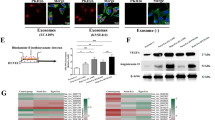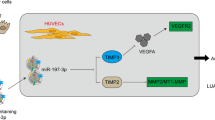Abstract
Background
Tumor hypoxia is a feature of tumor micro-environment (TME), which provides a suitable environment for tumor cells migration and invasion. However, up to now, the function of exosomes derived from hypoxic tumor cells is still not fully understood. The present study is aimed to explore the underlying mechanisms of lung cancer-secreted exosomes-mediated tumor metastasis under hypoxia.
Methods & Results
Exosomes were isolated from normoxic or hypoxic NCI-H446 cells. Some characteristic proteins were detected by western blots. Levels of CD63, CD 9 and CD 81 proteins were up-regulated on the membrane of exosomes secreted by hypoxic NCI-H446 cells. Basing on the results from miRNA sequencing, qRT-PCR and wound healing assay, hsa-miR-625-3p was discovered to be accumulated inside hypoxic exosomes and responsible for the metastasis of lung cancer cell. Further experiments from luciferase reporter gene assay demonstrated hsa-miR-625-3p could directly inhibit SCAI expression through binding with its 3’UTR, which suggested the mechanisms by which exosomal hsa-miR-625-3p suppressed tumor cells migration.
Conclusions
Exosomal miR-625-3p derived from hypoxic small lung cancer cells accelerated tumor cells migration through inhibiting SCAI directly.





Similar content being viewed by others
Abbreviations
- SCLC:
-
small cell lung cancer.
- TME:
-
tumor micro-environment.
- NTA:
-
nanoparticle tracking analysis.
- PCR:
-
polymerase chain reaction.
- EMT:
-
epithelia–mesenchymal transition.
- MAP2K6:
-
mitogen-activated protein kinase kinase 6.
- SCAI:
-
suppressor of cancer cell invasion.
- LTBP3:
-
latent TGFβ binding protein 3.
- SNED1:
-
sushi, nidogen and EGF-like domains 1.
References
Marozzi M, Parnigoni A, Negri A ( et al (2021) ) Inflammation, Extracellular Matrix Remodeling, and Proteostasis in Tumor Microenvironment.Int J Mol Sci22
Li J, Shi K, Sabet ZF et al (2019) New power of self-assembling carbonic anhydrase inhibitor: Short peptide-constructed nanofibers inspire hypoxic cancer therapy. Sci Adv 5:eaax0937)
Wortzel I, Dror S, Kenific CM, Lyden D (2019) Exosome-Mediated Metastasis: Communication from a Distance. Dev Cell 49:347–360)
Kim J, Kim TY, Lee MS, Mun JY, Ihm C, Kim SA (2016) Exosome cargo reflects TGF-beta1-mediated epithelial-to-mesenchymal transition (EMT) status in A549 human lung adenocarcinoma cells. Biochem Biophys Res Commun 478:643–648)
Yu DD, Wu Y, Shen HY et al (2015) Exosomes in development, metastasis and drug resistance of breast cancer. Cancer Sci 106:959–964)
Jiang H, Zhao H, Zhang M et al (2022) Hypoxia Induced Changes of Exosome Cargo and Subsequent Biological Effects. Front Immunol 13:824188)
Wang L, Yang G, Zhao D et al (2019) CD103-positive CSC exosome promotes EMT of clear cell renal cell carcinoma: role of remote MiR-19b-3p. Mol Cancer 18:86)
Lee HY, Chen CK, Ho CM et al (2018) EIF3C-enhanced exosome secretion promotes angiogenesis and tumorigenesis of human hepatocellular carcinoma. Oncotarget 9:13193–13205)
Liu B, Chen J, Shang F, Lian M, Shen X, Fang J (2022) () Tumor-Derived Exosome FGD5-AS1 Promotes Angiogenesis, Vascular Permeability, and Metastasis in Thyroid Cancer by Targeting the miR-6838-5p/VAV2 Axis. J Oncol 2022, 4702855
Lin H, Zhang L, Zhang C, Liu P (2020) Exosomal MiR-500a-3p promotes cisplatin resistance and stemness via negatively regulating FBXW7 in gastric cancer. J Cell Mol Med 24:8930–8941)
Yang Z, Chen JS, Wen JK et al (2017) Silencing of miR-193a-5p increases the chemosensitivity of prostate cancer cells to docetaxel. J Exp Clin Cancer Res 36:178)
Zhao L, Liu K, Pan X et al (2019) miR-625-3p promotes migration and invasion and reduces apoptosis of clear cell renal cell carcinoma. Am J Transl Res 11:6475–6486)
Huang S, Zou C, Tang Y et al (2019) miR-582-3p and miR-582-5p Suppress Prostate Cancer Metastasis to Bone by Repressing TGF-beta Signaling. Mol Ther Nucleic Acids 16:91–104)
Hoshino A, Costa-Silva B, Shen TL et al (2015) Tumour exosome integrins determine organotropic metastasis. Nature 527:329–335)
Sandfeld-Paulsen B, Aggerholm-Pedersen N, Baek R et al (2016) Exosomal proteins as prognostic biomarkers in non-small cell lung cancer. Mol Oncol 10:1595–1602)
Vaupel P, Mayer A (2007) Hypoxia in cancer: significance and impact on clinical outcome. Cancer Metastasis Rev 26:225–239)
Cazzoli R, Buttitta F (2013) microRNAs derived from circulating exosomes as noninvasive biomarkers for screening and diagnosing lung cancer. J Thorac Oncol 8:1156–1162Di Nicola M)
Chou NH, Lo YH, Wang KC, Kang CH, Tsai CY, Tsai KW (2018) MiR-193a-5p and – 3p Play a Distinct Role in Gastric Cancer: miR-193a-3p Suppresses Gastric Cancer Cell Growth by Targeting ETS1 and CCND1. Anticancer Res 38:3309–3318)
Rasmussen MH, Lyskjaer I, Jersie-Christensen RR et al (2016) miR-625-3p regulates oxaliplatin resistance by targeting MAP2K6-p38 signalling in human colorectal adenocarcinoma cells. Nat Commun 7:12436)
Zheng H, Ma R, Wang Q et al (2015) MiR-625-3p promotes cell migration and invasion via inhibition of SCAI in colorectal carcinoma cells. Oncotarget 6:27805–27815)
Rana S, Malinowska K, Zoller M (2013) Exosomal tumor microRNA modulates premetastatic organ cells. Neoplasia 15:281–295)
Acknowledgements
This study was supported in part by the grant from Beijing Hospitals Authority (XMLX201702).
Author information
Authors and Affiliations
Contributions
Yi Zhang contributed to the design of the experiment and writing the main manuscript. Kun Qian contributed to literature search and finishing the experiment, such as transmission electron microscopy (TEM), nanoparticle tracking analysis (NTA), flow cytometry, western blotting analysis and real-time reverse transcription polymerase chain reaction (RT-PCR). Xingsheng Liu contributed to data analysis and data interpretation. Teng Zhao contributed to the experimental data collection. Gaojun Lu contributed to writing the abstract.
Corresponding author
Ethics declarations
Conflict of interest
The authors have no relevant financial or non-financial interests to disclose.
Ethics approval
This article does not contain any studies with human participants or animals performed by any of the authors.
Additional information
Publisher’s Note
Springer Nature remains neutral with regard to jurisdictional claims in published maps and institutional affiliations.
Rights and permissions
About this article
Cite this article
Zhang, Y., Qian, K., Liu, X. et al. Exosomal mir-625-3p derived from hypoxic lung cancer cells facilitates metastasis by targeting SCAI. Mol Biol Rep 49, 9275–9281 (2022). https://doi.org/10.1007/s11033-022-07763-w
Received:
Revised:
Accepted:
Published:
Issue Date:
DOI: https://doi.org/10.1007/s11033-022-07763-w




